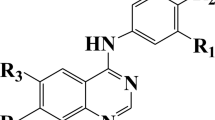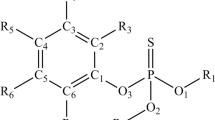Abstract
A radial basis function neural network (RBFN) has been used to correlate Ah receptor-binding affinities of polychlorinated, polybrominated, and polychlorinated–brominated dibenzo-p-dioxins with molecular weight and eight net atomic charge descriptors. Support vector machine (SVM) and partial least square (PLS) regression models based on the same data set have also been built. Leave-one-out cross-validation was used to train the RBFN, SVM, and PLS models. For predicting Ah receptor-binding affinities, the RBFN model with a squared cross-validation correlation coefficient (q 2) of 0.8818 outperforms the SVM and PLS models and also compares favorably with any other reported quantitative structure–activity relationship model based on the same activity data set. The significance of the RBFN model with net atomic charges as descriptors suggests that electrostatic and dispersion-type interactions play important roles in governing the Ah receptor binding of polychlorinated, polybrominated, and polychlorinated–brominated dibenzo-p-dioxins.





Similar content being viewed by others
References
Safe S (1986) Annu Rev Pharmacol Toxicol 26:371
Landers JP, Bunce NJ (1991) Biochem J 276:273–287
Murray JS, Evans P, Politzer P (1990) Int J Quant Chem 37:271–289
Waller CL, McKinney JD (1992) J Med Chem 35:3660–3666
Kafafi SA, Afeefy HY, Said HK, Kafafi AG (1993) Chem Res Toxicol 6:328–334
Gillner M, Bergman J, Cambillau C, Alexandersson M, Fernstro B, Gustafsson JA (1993) Mol Pharmacol 44:336–345
Poso A, Tuppurainen K, Ruuskanen J, Gynther J (1993) J Mol Struct Theochem 282:259–264
Wagener M, Sadowski J, Gasteiger J (1995) J Am Chem Soc 117:7769–7775
Waller CL, McKinney JD (1995) Chem Res Toxicol 8:847–858
Botani L, Fraschini E, Lasagni M, Modoni EP, Pitea D (1995) J Mol Struct Theochem 340:83–95
Fraschini E, Bonati L, Pitea D (1996) J Phys Chem 100:10564–10569
So SS, Karplus M (1997) J Med Chem 40:4360–4371
Tuppurainen K, Ruuskanen J (2000) Chemosphere 41:843–848
Asatryan RS, Mailyan NS, Khachatryan L, Dellinger B (2002) Chemosphere 48:227–236
Mhin BJ, Lee JE, Choi W (2002) J Am Chem Soc 124:144–148
Arulmozhiraja S, Morita M (2004) Chem Res Toxicol 17:348–356
Hirokawa S, Imasaka T, Imasaka T (2005) Chem Res Toxicol 18:232–238
Loukas YL (2000) Anal Chim Acta 417:221–229
Yao XJ, Zhang XY, Zhang RS, Liu MC, Hu ZD, Fan BT (2001) Comput Chem 25:475–482
Agatonovic-Kustrin S, Beresford R, Yusof APM (2001) J Pharm Biomed Anal 25:227–237
Yao XJ, Liu MC, Zhang XY, Hu ZD, Fan BT (2002) Anal Chim Acta 462:101–117
Yao XJ, Zhang XY, Zhang RS, Liu MC, Hu ZD, Fan BT (2002) Comput Chem 26:159–169
Yao XJ, Wang YW, Zhang XY, Zhang RS, Liu MC, Hu ZD, Fan BT (2002) Chemometr Intell Lab Syst 62:217–225
Yao XJ, Zhang XY, Zhang RS, Liu MC, Hu ZD, Fan BT (2002) Talanta 57:297–306
Wang YW, Zhang XY, Yao XJ, Gao YH, Liu MC, Hu ZD, Fan BT (2002) Anal Chim Acta 463:89–97
Wang YW, Gao SL, Gao YH, Liu SH, Liu MC, Hu ZD, Fan BT (2003) Anal Chim Acta 486:191–197
Gao YH, Wang YW, Yao XJ, Zhang XY, Liu MC, Hu ZD, Fan BT (2003) Talanta 59:229–237
Patankar SJ, Jurs PC (2003) J Chem Inf Comput Sci 43:885–899
Yao XJ, Fan BT, Doucet JP, Panaye A, Liu MC, Zhang RS, Zhang XY, Hu ZD (2003) QSAR Comb Sci 22:29–48
Yao XJ, Panaye A, Doucet JP, Zhang RS, Chen HF, Liu MC, Hu ZD, Fan BT (2004) J Chem Inf Comput Sci 44:1257–1266
Xue CX, Zhang RS, Liu HX, Liu MC, Hu ZD, Fan BT (2004) J Chem Inf Comput Sci 44:1267–1274
Xue CX, Zhang RS, Liu HX, Yao XJ, Liu MC, Hu ZD, Fan BT (2004) J Chem Inf Comput Sci 44:669–677
Yao XJ, Panaye A, Doucet JP, Chen HF, Zhang RS, Fan BT, Liu MC, Hu ZD (2005) Anal Chim Acta 535:259–273
Afantitis A, Melagraki G, Makridima K, Alexandridis A, Sarimveis H, Iglessi-Markopoulou O (2005) J Mol Struct Theochem 716:193–198
Denison MS, Pandini A, Nagy SR, Baldwin EP, Bonati L (2002) Chem-Biol Interact 141:3–24
So SS, Karplus M (1997) J Med Chem 40:4360–4371
Chang CC, Lin CJ (2001) LIBSVM: a library for support vector machines. http://www.csie.ntu.edu.tw/~cjlin/libsvm
Kaliszan R (1993) J Chromatogr A 656A:417–435
Shigeki K, Mai K, Keiichiro S, Yoko I, Akira T (1999) J Mol Struct 475:203–217
Author information
Authors and Affiliations
Corresponding author
Appendix
Appendix
-
AHH–aryl hydrocarbon hydroxylase
-
AhR–Ah receptor
-
bHLH–basic helix–loop–helix
-
CV–cross-validation
-
EROD–7-ethoxyresorufin O-deethylase
-
LOO–leave-one-out
-
PAS–Per–Arnt–Sim
-
PBDD–polybrominated dibenzo-p-dioxin
-
PCA–principal components analysis
-
PCB–polychlorinated biphenyl
-
PCDD–polychlorinated dibenzo-p-dioxin
-
PCDF–polychlorinated dibenzofuran
-
pEC50–the negative logarithm of the half-maximum effective concentration for assessing AhR-binding affinity of compounds
-
PLS–partial least squares regression
-
PRESS–predictive residual error sum of squares, \({\text{PRESS}} = {\sum\limits_{i = 1}^n {{\left( {\ifmmode\expandafter\hat\else\expandafter\^\fi{y}_{i} - y_{i} } \right)}^{2} } }\), \(\ifmmode\expandafter\hat\else\expandafter\^\fi{y}_{i}\) is the predicted value from cross-validation and y i is the experimental value.
-
PXDD–polychlorinated dibenzo-p-dioxin, polybrominated dibenzo-p-dioxin, or polychlorinated–brominated dibenzo-p-dioxin
-
q 2–the square correlation coefficient for cross-validation, \({\text{q}}^{2} = 1 - {{\text{PRESS}}} \mathord{\left/ {\vphantom {{{\text{PRESS}}} {{\sum\limits_{i = 1}^n {{\left( {y_{i} - \ifmmode\expandafter\bar\else\expandafter\=\fi{y}} \right)}^{2} } }}}} \right. \kern-\nulldelimiterspace} {{\sum\limits_{i = 1}^n {{\left( {y_{i} - \ifmmode\expandafter\bar\else\expandafter\=\fi{y}} \right)}^{2} } }}\), \(\ifmmode\expandafter\bar\else\expandafter\=\fi{y}\) is the average experimental value
-
QSAR–quantitative structure–activity relationship
-
QSPR–quantitative structure-property relationship
-
R–correlation coefficient,
$${\text{R}} = {{\sum\limits_{i = 1}^n {{\left( {x_{i} - \ifmmode\expandafter\bar\else\expandafter\=\fi{x}} \right)}{\left( {y_{i} - \ifmmode\expandafter\bar\else\expandafter\=\fi{y}} \right)}} }} \mathord{\left/ {\vphantom {{{\sum\limits_{i = 1}^n {{\left( {x_{i} - \ifmmode\expandafter\bar\else\expandafter\=\fi{x}} \right)}{\left( {y_{i} - \ifmmode\expandafter\bar\else\expandafter\=\fi{y}} \right)}} }} {{\sqrt {{\sum\limits_{i = 1}^n {{\left( {x_{i} - \ifmmode\expandafter\bar\else\expandafter\=\fi{x}} \right)}^{2} {\sum\limits_{i = 1}^n {{\left( {y_{i} - \ifmmode\expandafter\bar\else\expandafter\=\fi{y}} \right)}^{2} } }} }} }}}} \right. \kern-\nulldelimiterspace} {{\sqrt {{\sum\limits_{i = 1}^n {{\left( {x_{i} - \ifmmode\expandafter\bar\else\expandafter\=\fi{x}} \right)}^{2} {\sum\limits_{i = 1}^n {{\left( {y_{i} - \ifmmode\expandafter\bar\else\expandafter\=\fi{y}} \right)}^{2} } }} }} }}$$ -
RBFN–radial basis function neural network
-
RE–relative error
-
RMSE–root mean square error, \({\text{RMSE}} = {\sqrt {{{\sum\limits_{i = 1}^n {{\left( {\ifmmode\expandafter\hat\else\expandafter\^\fi{y}_{i} - y_{i} } \right)}^{2} } }} \mathord{\left/ {\vphantom {{{\sum\limits_{i = 1}^n {{\left( {\ifmmode\expandafter\hat\else\expandafter\^\fi{y}_{i} - y_{i} } \right)}^{2} } }} n}} \right. \kern-\nulldelimiterspace} n} }\)
-
SVM–support vector machine
Rights and permissions
About this article
Cite this article
Zheng, G., Xiao, M. & Lu, X.H. QSAR study on the Ah receptor-binding affinities of polyhalogenated dibenzo-p-dioxins using net atomic-charge descriptors and a radial basis neural network. Anal Bioanal Chem 383, 810–816 (2005). https://doi.org/10.1007/s00216-005-0085-7
Received:
Revised:
Accepted:
Published:
Issue Date:
DOI: https://doi.org/10.1007/s00216-005-0085-7




